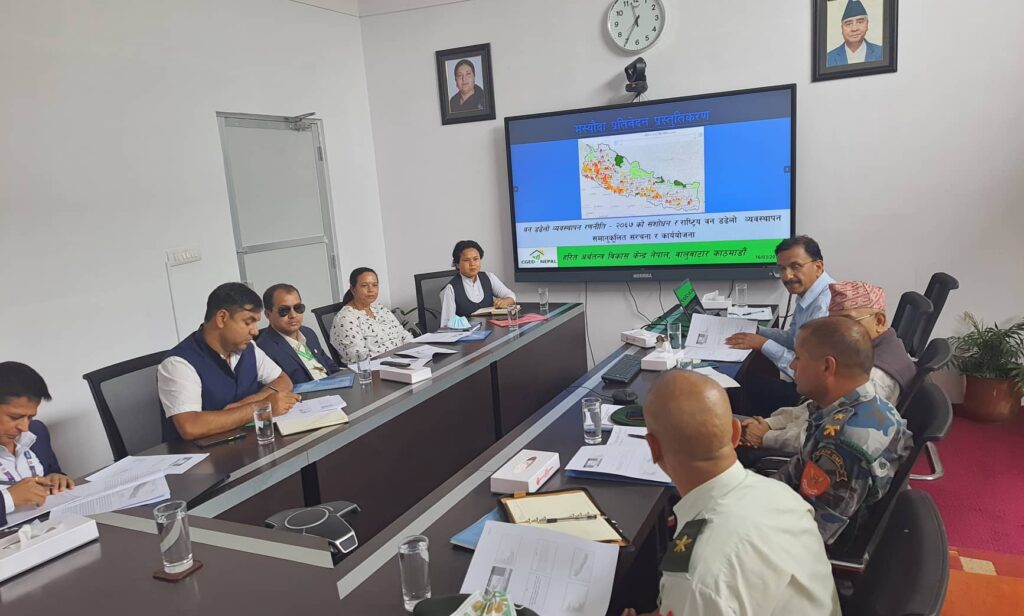Revision of Forest Fire Management Strategy-2067 and Preparation of Forest Fire Resilience Framework and Action Plan

Executing Agency: Center for Green Economy Development Nepal (CGED Nepal)
Funding Agency: Government of Nepal, Ministry of Home Affairs, National Disaster Risk Reduction and Management Authority (NDRRMA)
Office Address :- Singhadarbar, Kathmandu.
Project Summary
Contract N0: NDRRMA/FFMS/01-2078/79
Project Agreement Date: 20 May, 2022
Project Completion Date: 20 July, 2022
Project Period: 3 months
Proposal Summary
As envisioned in National Disaster Risk Reduction and Management Act of 2017, National Disaster Risk Reduction and Management Authority (NDRRMA) was established on 16 December, 2019, under ministry of Home Affairs, with the appointment of its Chief Executive. The main responsibility of NDRRMA is to reduce disaster risk and manage to protect human lives and property. This authority has the mandate to act as the central resource and coordinating agency for disaster risk and management. With the establishment of NDRRMA, the work related to Disaster Risk and Reduction and Management has been expedited.
In Recent years, due to climate change forest fire has become one of the threats in Nepal which hits the life people and economy as well as bio-diversity sector. NDRRMA has identified forest fires as one of major disasters and with climate change the risk continues to grow. Every year, during dry season from mid-November till May, forest fire destroys about 200,000 hectares of forest and takes life of ten persons in an average. Generally, peak fire season occurs sometimes in the fourth week of April (second week of Baishakh). The year 2009 was exceptionally disastrous year from forest fires, 338 fires occurred in a single day in 25 April. Total 49 person’s lives were lost including 13 army personnel. Furthermore, Nepal experienced a record breaking and historic incidence of forest fire in 2020/021 fire season. A total of 6799 forest fires occurred in 2020/2021 fire season which is ten times more than of 2019/2020 fire season. 11 persons died, 4 persons injured while dosing those fires or trapped by fires and 4 houses burned down to ashes. The haze from forest fire covered most of the sky of Nepal, resulting closures of schools and many flights. To address the forest disaster risk reduction and management, Ministry of forest and soil conservation (then) now, Ministry of forest and Environment (MoFE) has promulgated ‘Forest Fire Management Strategy- 2067’ with the long-term objective to mitigate has loss of life, properties, forest resources, biodiversity and ecosystem by uncontrolled forest fires.
National disaster risk reduction and management authority, It has been felt necessary to revise the strategy in light of changing context including climate extreme, institutional and technological development. For this, NDRRMA has plan to revise the strategy and prepare the National Fire Resilience Framework and Action Plan.
Scope of the Service
To revise the Forest Fire Management Strategy 2067 and prepare the ‘National Forest Fire Resilience Framework and Action Plan.
Main Objectives
To revise forest fire management strategy 2067 and prepare Nepal’s National Forest Fire Resilience Framework and Action plan. It includes:
Specific Objectives
Review and reflection on the status of implementation of Forest Fire Management Strategy – 2067;
Identify gaps in implementation of the strategy;
Draft ‘forest fire management Strategy 2067 (First revision -2078) – Nepali and English versions;
Draft ‘National Forest Fire Resilience Framework and Action Plan – Nepali and English Versions; and
Prepare prioritized programs for short (up to two years), medium term (for five years) and long term (by 2030)
Methodology
Task force formation by NDRRMA including MoFE and relevant agencies.
Literature review (National and International context;
Consultative meetings with ‘task force and key stakeholders;
One provincial multi-stakeholder consultative workshop;
One National multi- stakeholder sharing workshop;
